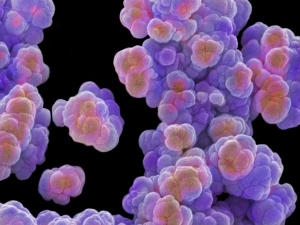April 4, 2014 – The Great Dying happened 252 million years ago. This mass extinction event at the end of the Permian wiped out 90% of life on Earth. What caused it?
There are lots of theories. They include:
- The coming together of the continental plates to form the super-continent Pangea disrupting the ecosystems reliant on the continental shelves. This one is highly speculative.
- A significant climate fluctuation leading to glaciation, a significant drop in sea levels worldwide, and significant cooling and drying from the mid-latitudes to the equator disrupting plants and the growing season on land and overall ocean temperatures.
- The eruption of the Siberian traps, an enormous super volcano that would have produced continuous eruptions over a fairly long period of time leading to an extended “nuclear” winter.
To these theories now add the newest – microbes. Microbes, those single-celled plants and animals that were the first life on the planet have altered the chemistry of our world since first emerging 3.5 billion years ago. The planet was a much different place back then with the crust seething with volcanoes, with debris from the newly formed Solar System continuing to rain down from space, and with outgassing from the fluid mantle. Some of the debris that struck our Earth brought water to the planet surface with the bearers being icy comets. The conditions for life were set. And when life emerged or arrived (it may have come on a comet) all that existed before changed. We owe our lives to the microbes that preceded us. They ventured forth into the pools of comet-delivered water that eventually formed our oceans. They created the oxygen we breathe and that led to us.
So how could life have caused an extinction event?
What we know about the end of the Permian period is that vulcanism in Siberia was very extensive. We know this because of the basalt left behind covering 2.5 million square kilometers (965,000 square miles) and extending to depths of 3 kilometers (1.86 miles) in some places. We also know that the atmosphere at the time was much warmer than today and the oceans were more acidic. We know this from sampling the chemistry of sediments laid down during this geological period.
So wouldn’t that be explanation enough for the Great Dying?
Researchers at Massachusetts Institute of Technology (MIT) studying the Permian extinction have accumulated new evidence to suggest an additional suspect. They describe evidence of large accumulations of organic matter in ocean sediments that was a meal in waiting with no takers to it eat it. It seems that the microbes of the early Permian couldn’t digest this rich trove of organic matter until they evolved new digestive attributes.
The microbe, Methanosarcina, which was abundant at the time, and still can be found today, evolved by capturing acetate-processing genes from another bacterium. When? The date according to MIT scientists was approximately 250 million years ago. That lines up pretty much with the date of the Permian extinction. Methanosarcina (seen in the image below) with new digestive enzymes on board could now take advantage of that rich organic trove of food lying in ocean sediments. And just like the feeding frenzy algae experiences in lakes with phosphorous-laden fertilizer from farm runoff leading to gigantic blooms, the Methanoscarcina population would have done the same thing. The Earth’s oceans would have been covered by massive blooms which on dying would have released large volumes of methane gas into the atmosphere. The evidence for the blooms can be found in the carbon isotopic record within sediments from the Permian-Triassic boundary.
But can a massive bloom produced by a single-celled microbe have caused the dying both on land and sea? The scientists aren’t convinced that the microbes solely contributed to the Permian extinction. They believe extinction happened through a combination of Siberian volcanic activity and the biological activity of Methanosarcina. Methane would have killed most of the life on land. Oxygen depletion and acidification would have destroyed most living things in the sea.
So what lessons can we learn from this? If a microbe can cause a mass extinction event by altering the chemistry of the planet, what can a human do pumping carbon into the air and through it acidifying the ocean?












